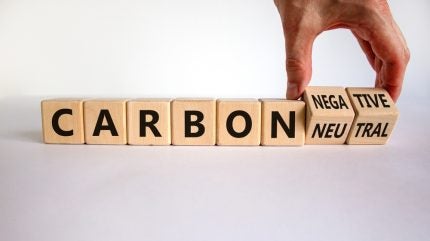
As climate change intensifies and global supply chains come under scrutiny, businesses and consumers alike are turning their attention to packaging—not just as a functional necessity but as a key driver of environmental impact.
Among the latest innovations, carbon negative packaging is gaining ground as a powerful solution in the fight against emissions.

Discover B2B Marketing That Performs
Combine business intelligence and editorial excellence to reach engaged professionals across 36 leading media platforms.
Unlike traditional packaging, which typically adds carbon to the atmosphere through production and waste, carbon negative materials go one step further: they actively remove more CO₂ than they emit during their life cycle.
This emerging sector is redefining what sustainability means in packaging, offering hope for brands looking to meet net-zero goals and for consumers seeking greener choices.
What makes packaging carbon negative?
To be labelled as carbon negative—sometimes referred to as climate positive—packaging must achieve a net reduction in atmospheric CO₂. This is often done by integrating materials that sequester carbon during their growth or production.
For instance, plant-based packaging made from fast-growing biomass, such as hemp, bamboo, or agricultural waste, can absorb significant amounts of carbon as the plants grow. If processed and manufactured using renewable energy, the final product may result in a negative carbon footprint.

US Tariffs are shifting - will you react or anticipate?
Don’t let policy changes catch you off guard. Stay proactive with real-time data and expert analysis.
By GlobalDataAnother route to carbon negativity is through innovative material engineering. Some packaging companies are experimenting with biochar, a carbon-rich by-product of biomass pyrolysis.
When embedded into packaging materials, biochar locks carbon away for hundreds of years, effectively acting as a carbon sink. These solutions often combine carbon capture with circular design principles, allowing materials to be reused, composted, or returned to the earth without harmful emissions.
Crucially, achieving carbon negativity isn’t just about the raw material; the entire life cycle of the product must be considered. This includes energy used in manufacturing, transportation emissions, consumer use, and end-of-life disposal.
Companies that succeed in creating truly carbon negative packaging often rely on verified carbon footprint analysis to quantify their impact, supported by lifecycle assessments and third-party certifications.
Leading innovations and materials
The market for sustainable packaging has rapidly evolved, with several pioneering materials now available that offer genuine carbon negative potential.
One of the most promising is mycelium packaging, made from the root structure of fungi.
Grown using agricultural waste, mycelium forms durable, biodegradable packaging that breaks down naturally within weeks. It requires minimal energy to produce and can often be grown on-site, drastically reducing transport emissions.
Algae-based packaging is another solution on the rise. Seaweed and algae absorb large quantities of CO₂ during growth, and some varieties can be harvested in regenerative systems that support marine biodiversity.
These materials can be used for films, sachets, and wrapping—often in applications like single-use food packaging or personal care items.
In some regions, carbon negative packaging is also being driven by carbon offset programmes, where packaging producers invest in verified carbon capture projects—like reforestation or direct air capture—to balance and surpass their own emissions.
While not a substitute for low-emission design, offsets can help push a product’s carbon balance into negative territory.
Brands such as Notpla, Ecovative, and Loliware are pushing the envelope in this space, combining science, design, and nature to produce viable, scalable alternatives to plastics and fossil-fuel-based packaging.
Their work has captured the attention of major retailers and sustainability-conscious investors alike.
Challenges to scaling carbon negative solutions
Despite its promise, carbon negative packaging is not yet mainstream. One of the primary barriers is cost. Novel materials often carry a price premium due to the complexity of their supply chains and the relatively small scale of production.
Many carbon negative options are still in early stages of development and rely on niche markets or pilot programmes.
Consumer perception can also be a hurdle. While there is increasing awareness around eco friendly packaging, the term “carbon negative” is still unfamiliar to many. Education and transparent labelling will be vital to building trust and driving adoption.
Moreover, performance remains a key consideration: packaging must not only be sustainable but also protect products, extend shelf life, and withstand the demands of distribution.
From a regulatory perspective, there is growing momentum in favour of eco packaging solutions, particularly in the EU and UK, where legislation is tightening around single-use plastics and extended producer responsibility.
However, clearer definitions and standards for what constitutes “carbon negative” are needed to prevent greenwashing and ensure consistent evaluation.
The road ahead for carbon negative packaging
The shift towards carbon negative packaging is more than a trend—it reflects a broader rethinking of how we package, deliver, and consume goods in a carbon-conscious world. As climate policies strengthen and sustainable packaging solutions become a competitive advantage, demand is likely to grow.
Investments in biotechnology, renewable energy, and circular design are expected to reduce costs over time, while innovations in materials science continue to open up new possibilities.
For businesses aiming to reduce their environmental footprint, carbon negative packaging could soon move from niche to necessity.
As consumers, choosing products with low carbon packaging is a simple yet powerful way to influence the market. Whether it’s compostable mailers, mushroom-based containers, or seaweed wraps, every choice counts in building a more sustainable future—one box, bottle, or bag at a time.





